All bicycle owners should know how to perform routine maintenance and care, and learning the basics of repair can help save a lot of money in the long term.
E-bike maintenance and care involves the regular upkeep of both the mechanical parts and knowing how to treat the electrical components so they last as long as possible.
Electric bike repair is more complicated. A qualified e-bike mechanic should address any problems that extend past simple troubleshooting issues.
This article will explore the fundamentals of electric bike repair, maintenance, and care so you can keep your e-bike in top shape.
How Often Should You Do an E-Bike Service?
It’s recommended to have an e-bike serviced roughly every 1,000 to 1,500 miles or three to nine months based on usage. Some owner’s manuals offer suggested servicing guidelines.
If you ride in a wet climate or on muddy trails frequently, the frequency should be higher, as dirt buildup and water exposure can cause components to wear faster.
This full e-bike service should be done in addition to regular cleaning, lubrication, tire inflation, and brake adjustment.
Electric Bike Repair Basics
Electric bike repair is quite complex. Repairing electronic components such as motors, batteries, controllers, and sensors requires a high level of training that even some regular bike mechanics don’t have.
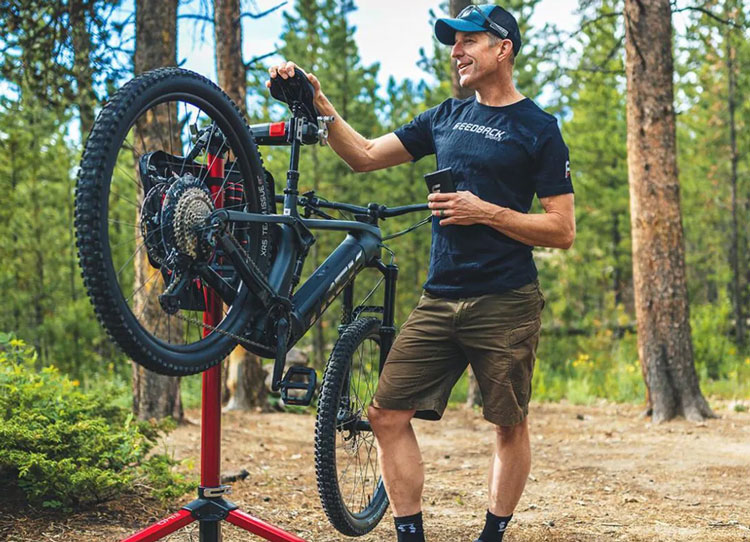
(Source: Feedback Sports)
Given that, it’s best to leave the repair of electrical components to professionals.
Any confident home mechanic can still perform e-bike repairs on common issues with the mechanical components, such as the drivetrain, brakes, wheels, and tires.
Warranty
Knowing the details of your warranty is essential for electric bike owners who buy new.
All e-bikes sold in the US must have a minimum warranty of one year on manufacturing defects. This means the company must repair, replace, or refund you if you experience an issue with your electric bike that does not result from misuse.
Most big-name bike brands offer longer warranties on mechanical components or even limited lifetime warranties on frames and rims in some cases.
However, the motor and battery rarely get more than two years of coverage for electric bike repairs.
Find a Qualified Bike Mechanic or Retail Partner for Your E-Bike
E-bike repair requires a different set of skills than many traditional bike mechanics possess. For this reason, some bike shops won’t service e-bikes. Others will only service particular brands or premium e-bikes that are well-designed.
Cheap models from small manufacturers are notoriously hard to work on and can cause lots of issues, so many mechanics will avoid working on them.
If you plan on buying a cheap e-bike online, find a qualified mechanic willing to work on it before you make the purchase.
By buying from a shop or online from a brand like REI, you can rely on the shop to take care of electric bike repairs and servicing when you experience an issue.
Motor and E-Bike Battery Repairs
Attempting to repair an e-bike motor or battery will almost certainly void the warranty. In addition, E-bike battery repair can easily compromise the internals and cause overheating, shortcircuiting other electronic components, or even an e-bike fire.
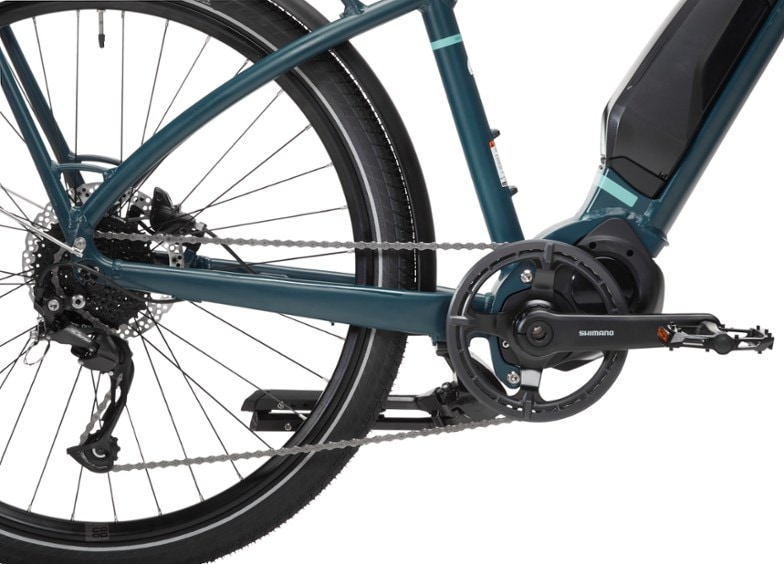
(Source: REI.com)
Likewise, motors shouldn’t be worked on at home. In general, e-bike motors are very durable and require little-to-no maintenance. When they stop working, it’s usually time to replace them. However, sometimes issues occur inside the warranty that the manufacturer must address.
Electric Bike Repair: Troubleshooting Errors At Home
The average electric bike owner can do a couple of things to troubleshoot their e-bike when it experiences an error. However, most issues require the assistance of a professional e-bike mechanic.
From time to time, electric bike batteries and motors will encounter issues that bring up an error code on the display, indicating that something is wrong. Sometimes you can address these errors by turning the bike off and back on again.
Alternatively, some e-bikes have companion apps that diagnose the error and provide instructions on whether the owner or a mechanic must fix it.
If your e-bike isn’t turning on at all, it’s possible that the battery isn’t seated correctly in its holder or a connecting cable has come loose. Additionally, the battery connectors could have been bent or damaged while it was removed for charging.
Speed Sensor Blockage or Alignment Issue
If your e-bike is turning on but not providing pedal assistance, there’s a possibility the speed sensor is out of alignment or blocked.
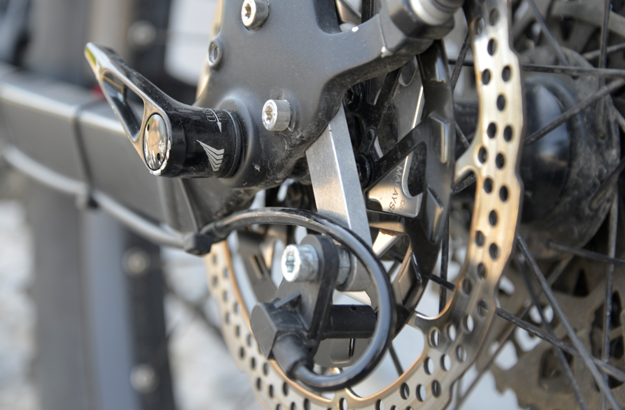
(Source: Ineltro.eu)
Almost all e-bikes have a speed sensor magnet attached to a spoke in the rear or installed at the rear brake rotor. The spoke-mounted magnet passes by a sensor on the inside of the chainstay.
To ensure the sensor isn’t causing the issue, wipe the magnet and the sensor with a damp cloth so that they aren’t blocked, and check that they are aligned. Also, brake dust may gather on the sensor for rotor-mounted magnets, so wipe this off with a clean, dry rag.
E-Bike Maintenance and Care
As mentioned above, e-bike maintenance and care is an ongoing process that owners who ride regularly should integrate into their routine. Doing so will save money in the long term by prolonging the life of each component.
In addition, a well-maintained bicycle is more enjoyable to ride. So, what can the average e-bike owner do to maintain their e-bike?
Best Practices for E-Bikes Motor and Battery Care
The lifespan of an e-bike’s electrical components is highly dependent on how the bike is used, stored, and charged.
An owner who follows best practices could get triple the lifespan of one who doesn’t.
So let’s take a look at the best practices.
How to Charge Your Battery Optimally
To maximize the lifespan of your battery, you will want to charge it more frequently. Avoid charging it to 100% or allowing it to fall below 30%. Ideally, you want to maintain a charge between 30 and 90%.
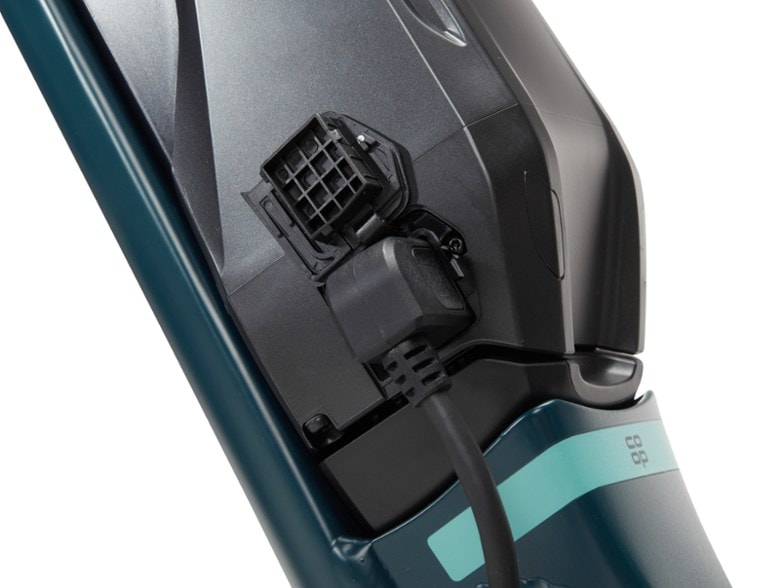
(Source: REI.com)
If you must leave it to reach 100%, ensure you unplug it at that point, and don’t leave it plugged in after finishing. The quickest way to speed up battery deterioration is to do a full discharge and charge regularly.
Storage In a Cool and Dry Place
E-bike batteries are susceptible to heat and water exposure. For this reason, it’s best to store them short-term and long-term in a cool, dry area away from direct sunlight and heat sources.
If your only option is to keep the bike outside, use a heavy-duty waterproof cover and remove the battery to store it inside.
For long-term storage, ensure the tires have some air and maintain between 30 and 70% charge in the battery.
Storing a lithium-ion battery with a full charge or below 20% can damage it so that it doesn’t hold any charge when you start using it again.
- Read more: How Long Does an E-Bike Battery Last?
Use Lower Gears and Pedal Assistance Levels
On mid-drive e-bikes, the motor is much more efficient when you maintain a consistent and high cadence of 75 to 100 rpm. Like our knees, motors don’t like to churn away at low RPMs; it puts extra stress on the system.

(Source: REI.com)
Similarly, using the high pedal assistance for most of your riding will put a lot of extra stress on the motor and battery, causing heat buildup and reducing lifespan.
Riding in extremely hot environments (above 90°F) accentuates this problem.
Again, heat is the common denominator here, and it applies to riders and electronics alike. The more work a system does, the more heat it generates and the faster it wears out.
Use the Original Charger and Battery
Only use the original charger provided with your electric bike.
If you must replace it, only buy one sold specifically by the bike brand or e-bike system manufacturer for your model. Using the wrong charger can damage the battery and cause a fire.
If you must replace the battery on your e-bike, buy the same model from the bike brand itself or the system manufacturer (Bosch, Bafang).
Using the incorrect battery could cause the electric components in your bike to shortcircuit, rendering the bike unusable.
E-Bike Maintenance of Mechanical Components
On top of caring for the electronic parts of your e-bike, you should dedicate time regularly to cleaning and maintaining the mechanical components, like the drivetrain, brakes, tires, and frame.
What to Do After Riding in the Rain
One of the key things to keep an ebike running smoothly and extend the lifespan of the individual components is to give it a quick clean after riding in the rain, especially if you ride off-road.

Allowing dirt and grime to build up in the various nooks and crannies of the bike will cause the components to lose efficiency and deteriorate faster.
Use a bucket of water or a weak hose to rinse the frame and components. Then, wipe any dirt buildup off the chain with an old rag, and reapply lube to it. But, before all of that, make sure to remove the battery as it should never be soaked in water.
If you’ve ridden in particularly muddy conditions, you may want to do a deep drivetrain cleaning and lubrication.
Chain and Drivetrain: Apply Lube and Clean Frequently
The frequency at which you apply lube and clean the drivetrain depends on the climate where you live and how frequently you ride.
Thankfully, most e-bikes use single-chainring drivetrains, so the maintenance is more straightforward, and there is less to go wrong.
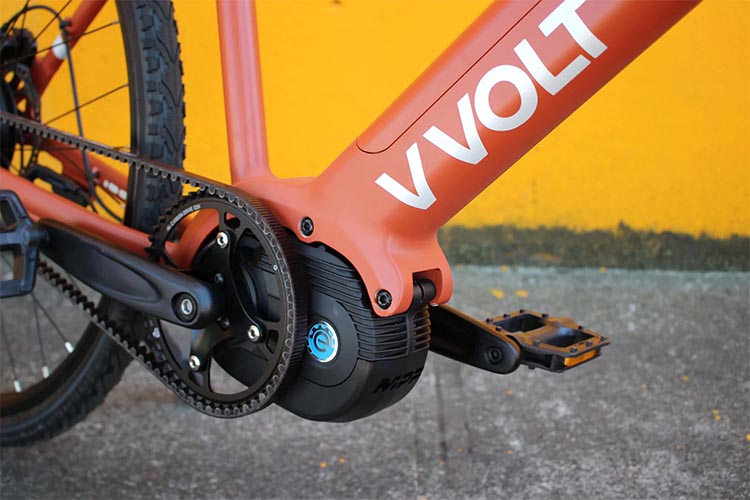
Ebikes with belt drives require very little maintenance as the belt doesn’t need to be cleaned or lubricated. (Source: Vvolt.com)
If riding in dry conditions, reapply lube to the chain every 150 miles or so. Again, if you ride in wet or very dusty conditions, you must wipe down your chain before reapplying lube.
Perform a full drivetrain cleaning and lubrication every month to six weeks for urban e-bikes or electric road bikes. Off-road riders should perform one more often, roughly every two weeks.
E-bike owners should also check the chain for wear periodically. Use a chain wear tool to determine whether or not it’s ready to be changed.
An e-bike chain should last roughly 2,000 miles. However, hub-drive models can last longer as the motor power isn’t transferred through the drivetrain.
Brakes
Almost all e-bikes have disc brakes, the best type for stopping these heavy, fast, and powerful machines. However, the extra demands on electric bike brakes mean they wear down quickly, leading to deterioration in efficiency, power, and consistency.
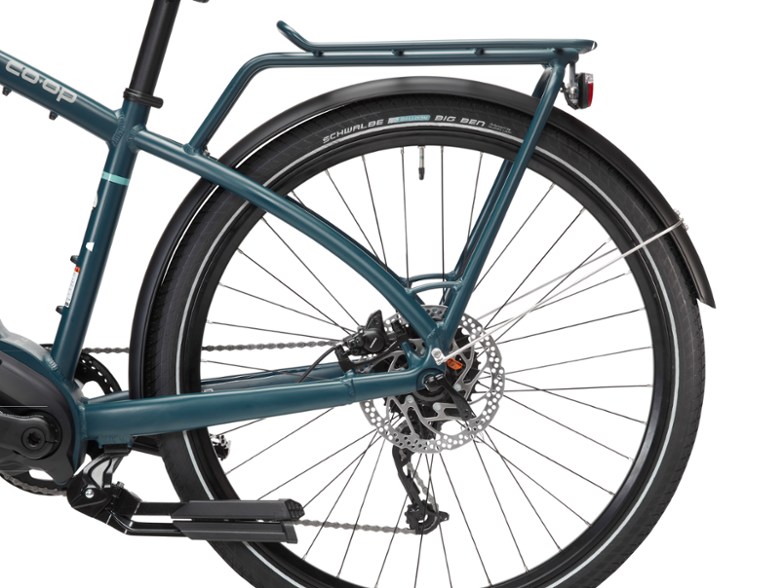
(Source: REI.com)
Riders should be conscious of the deteriorating performance and adjust or replace the pads, rotors, and hydraulic fluid when necessary. The brakes on lots of budget or entry-level e-bikes wear extremely quickly.
If you’re uncomfortable adjusting or replacing the components on your brakes at home, take the bike to your local bike shop.
Tires
Keep your tires inflated within the manufacturer’s specified range to ensure your bike rolls smoothly and efficiently and avoid pinch flats.
You may need to do this every couple of rides if you have narrow tires and every three or four rides for wider, high-volume tires (2″ and above).
Learn how to repair a flat on your e-bike. Doing it on hub drive e-bikes is more complicated as you must disconnect the motor when replacing a flat on the wheel with a motor.
The manufacturer’s user manual should provide step-by-step instructions so you know which cable to disconnect.
Electric Bike Repair and Maintenance: Key Takeaways
In conclusion, electric bike owners should prioritize proper maintenance and care of both mechanical and electrical components to prolong the lifespan of their e-bike.
Regular servicing is advised every 1,000 to 1,500 miles or three to nine months, with additional attention required for those riding in wet or muddy conditions.
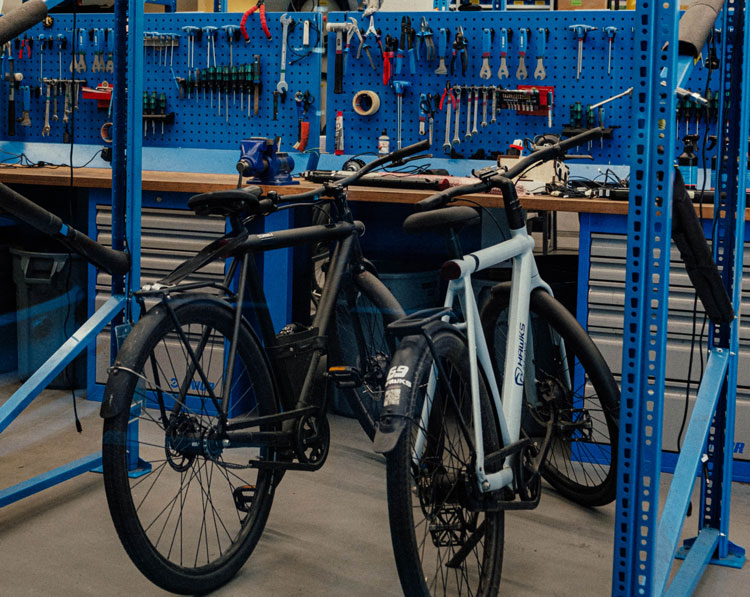
While mechanical repairs can be done at home, electrical repairs should be left to qualified professionals.
To maximize the lifespan of e-bike batteries, follow best practices for charging and storage, and use only original chargers and batteries.
Regularly clean, lubricate, and maintain mechanical components like the drivetrain, brakes, and tires to ensure a smooth and enjoyable ride.
Read Next
Best Low-Maintenance Belt-Drive E-Bikes
Best Low-Maintenance Single-Speed Electric Bikes
How to Make Your E-Bike Faster: 7 Easy Ways to Boost E-Bike Speed
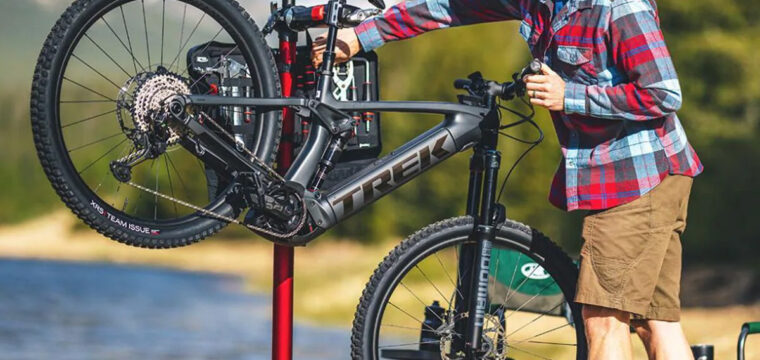
Your Feedback is Important!